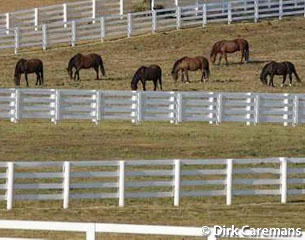
J. Poulsen, E. Søndergaard, N. Luthersson, and J. Malmkvist of the department of Animal Science at the Aarhus University investigated the behaviour and stress responses in horses with gastric ulceration.
The prevalence of gastric ulceration is surprisingly high in horses according to several recent studies. However, very little is known about the consequences of gastric ulcers, and whether affected horses respond differently to acute stressors, which is of importance for both horse performance and welfare.
We aimed to investigate whether horses with severe glandular gastric ulceration have a higher basal concentration of stress hormones, measured as faeces cortisol metabolites (FCM; analysed using an enzyme-immuno assay), and react differently (1) in a novel object test (NOT), and (2) during postponed feeding. Additionally, we studied whether eating behaviour and the occurrence of abnormal behaviour differ between horses with and without severe gastric ulcers.
After gastroscopic examination of 98 Danish Warmblood horses (3-19 y) at one private stud, we selected two groups of horses: an ulcer group (n=30) with severe gastric ulcer lesion in the glandular mucosa (score 3-4) and a paired control group with intact gastric mucosa (n=30). Horses were then tested in a novel object test (NOT, Day 1), and exposed to a postponed feeding test (Day 2) in their home box. Faeces for determination of cortisol metabolites were collected before and after the NOT; heart rate was measured during the NOT, combined with behaviour recorded on video in both situations for later analysis.
There was no obvious external signs, e.g. in body condition score, differing between control and ulcer horses. Controls spent longer time ingesting a small amount of feed given as part of the postponed feeding test (control: 126±10.2 vs. ulcer: 94±11.2 s, RM-ANOVA P=0.025), and spent more time moving during the test (P=0.03).
We found no association between glandular gastric ulceration and the performance of abnormal behaviour (ANOVA P=0.46); crib biting was rarely observed (one ulcer horse only). Fearfulness (behaviour, heart rate) did not differ in the NOT; however, whereas the baseline FCM was equal between the groups (control: 5.3±1.93, ulcer: 5.7±2.03 ng/g; ANOVA P=0.79), horses with gastric ulcers showed a higher endocrine response after the NOT (7.3±0.81 vs. control: 5.8±0.79 ng/g, P=0.02). This may indicate that ulcerated horses are more responsive to acute stressors.
There was surprisingly little difference between groups of horses with and without severe gastric ulceration from the same stable, fed equal amounts of starch and hay; e.g. all horses were in good body condition and crib biting was rarely observed. Horses with severe gastric ulceration reacted, however, physiologically more after a novelty test, i.e. they may be more sensitive to novelty-induced stress.
-- 2011 ISES Conference Abstract
Photo © Dirk Caremans
Related Links
Whipping of Race Horses is Influenced by Jockey's Experience
KWPN to Publish Osteochondrosis Results in January 2012